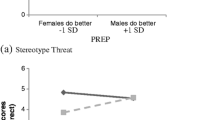Abstract
On standardized tests of mathematical problemsolving, the typical finding has been that women scorelower than men. Experiment 1 manipulated gender labeling(female character, male character, or gender neutral) within the problem question to seewhether this accounted for gender differences inmathematical problem solving. Sixty-four seventh andeighth graders were tested on modified versions of theCanadian Test of Basic Skills (CTBS) with the resultsshowing that although gender labeling affected studentsperformance, it did not account for gender differences.Experiment 2 manipulated both gender labeling and gender stereotype threat for 174 universitystudents writing modified versions of a modelStandardized Achievement Test (SAT). Again, genderlabeling within problem questions did not account forgender differences. However, women scored lower thanmen when they believed that the test had previouslyshown gender differences. There was no gender differencein the performance of the same women and men when they believed that the test was merelycomparing Canadian students with American students. Thissuggests that gender stereotype threat could be a keyfactor in explaining gender differences in mathematical problem solving.
Similar content being viewed by others
REFERENCES
Benbow, C. P. (1988). Sex difference s in mathematical reasoning ability in intellectually talented preadole scents: Their nature, effects, and possible causes. Behavioral and Brain Sciences, 11, 169–232.
Benbow, C. P.,& Stanley, J. C. (1980). Sex differences in mathematical ability: Fact or artifact? Science, 210, 1262–1264.
Catsambis, S. (1994). The path to math: Gende r and racial ethnic difference s in mathematics participation from middle school to high school. Sociology of Education, 67, 199–215.
Chipman, S. R., Marshall, S. P., & Scott, P. A. (1991). Contents effects on word problem performance: A possible source of test bias? American Educational Research Journal, 28, 897–915.
D'Ailly, H., Simpson, J., & MacKinnon, G. (1997). Where should `you' go in a math compare problem. Journal of Educational Psychology, 89, 562–567.
Duffy, J., Gunther, G., & Walter, L. (1997). Gender and mathematical problem-solving. Sex Roles, 37, 477–494.
Eccles, J., Wigfield, A., Harold, R., & Blumenfeld, P. (1993). Age and gende r difference s in children's self and task perceptions during elementary school. Child Development, 64, 830–847.
Feingold, A. (1988). Cognitive gender difference s are disappearing. American Psychologist, 43, 95–103.
Hyde, J. S., Fennema, E., & Lamon, S. J. (1990). Gender differences in mathematics performance: A meta-analysis. Psychological Bulletin, 107, 139–155.
Hyde, J. S., Fennema, E., Ryan, M., Frost, L. A., & Hopp, C. (1990). Gender comparisons of mathematics attitudes and affect. Psychology of Women Quarterly, 14, 229–324.
Jackson, L. A., Fleury, R. E., Girvin, J. L., & Ge rard, D. A. (1995). The numbers game: Gender and attention to numerical information. Sex Roles, 33, 559–569.
Jacobs, J. E., & Eccles, J. S. (1985). Gender differences in math ability: The impact of media reports on parents. Educational Research, 20–25.
Kimball, M. M. (1989). A new perspective on women's math achievement. Psychological Bulletin, 105, 198–214.
Matthews, D. J., & Keating, D. P. (1995). Domain specificity and habits of the mind: An investigation of patterns of high leve l development. Journal of Early Adolescence, 15, 319–343.
Steele, C. M. (1997). A threat in the air: How stereotypes shape intellectual identity and performance. American Psychologist, 52, 613–629.
Steele, C. M., & Aronson, J. (1995). Stereotype threat and the intellectual test performance of African Americans. Journal of Personality & Social Psychology, 69, 797–811.
Whitehead, J. (1996). Sex stereotypes, gender identity and subject choice at A leve l. Educational Research, 38, 147–160.
Rights and permissions
About this article
Cite this article
Walsh, M., Hickey, C. & Duffy, J. Influence of Item Content and Stereotype Situation on Gender Differences in Mathematical Problem Solving. Sex Roles 41, 219–240 (1999). https://doi.org/10.1023/A:1018854212358
Issue Date:
DOI: https://doi.org/10.1023/A:1018854212358




